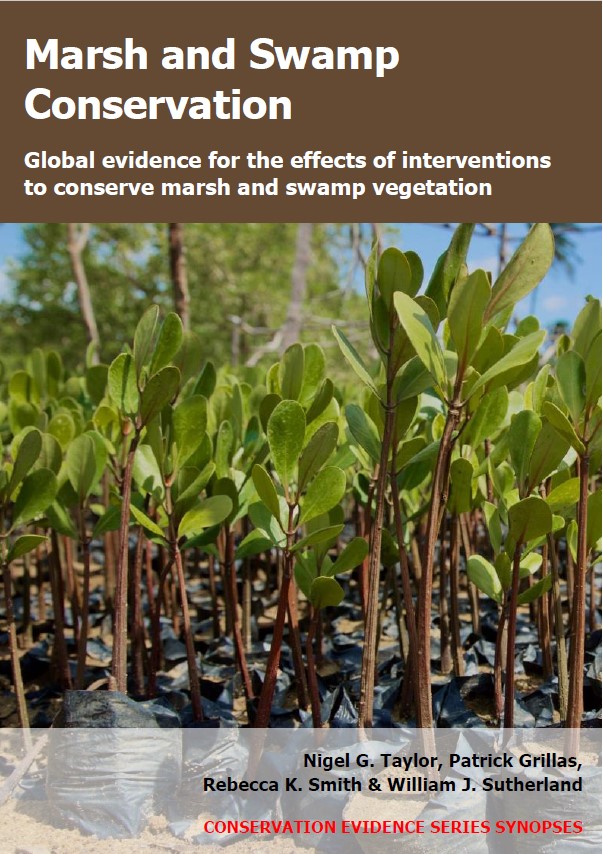Change season/timing of vegetation harvest: freshwater marshes
-
Overall effectiveness category Likely to be beneficial
-
Number of studies: 3
View assessment score
Hide assessment score
How is the evidence assessed?
-
Effectiveness
50% -
Certainty
50% -
Harms
0%
Study locations
Supporting evidence from individual studies
A replicated, randomized, paired, controlled study in 1983–1986 in two wet meadows in Switzerland (Buttler 1992) reported that summer and winter harvesting had similar effects on overall plant community composition and structure, but different effects on some individual plant species. Statistical significance was not assessed. Over 3–4 years, plots harvested in summer and winter experienced similar changes in overall plant community composition (partial data reported as a graphical analysis). Both harvest regimes were associated with a significant increase in the proportion of vegetation in lower layers. This was true for vegetation overall, and the dominant species in each community (partial data reported, as number of times survey pins touched living vegetation). Some individual species responded differently to each harvest regime. For example, common reed Phragmites communis developed more, thinner shoots and lower above-ground biomass over four years of summer harvest, but developed fewer, thicker shoots and greater above-ground biomass over three years of winter harvest (see original paper for partial data). Methods: Two pairs of plots (each 121–169 m2) were established in two historically mown, but abandoned, lakeside wet meadows. In each pair, one random plot was mown in winter (from early 1983) and one random plot was mown in late summer (from 1983). Cuttings were removed. Vegetation was surveyed each summer 1983–1986 (before harvest, where applicable).
Study and other actions testedA replicated, paired, before-and-after study in 1986–1988 in five wet grasslands in Belgium (Dumortier et al. 1996) reported mixed effects of single annual harvests, between June and November, on plant species richness and biomass. Statistical significance was not assessed. Over two years, plant species richness increased in plots harvested between July and October (from 15–19 to 18–20 species/6 m2). It declined in plots harvested in November (from 19 to 18 species/6 m2) and was stable in plots harvested in June (17 species/6 m2). Total above-ground biomass (including litter) declined in plots harvested between August and October (from 550–730 g/m2 to 480–560 g/m2). It increased in plots harvested in June, July or November (from 310–660 g/m2 to 410–780 g/m2). The study also reported data on the cover of some example individual plant species (see original paper). Methods: In spring 1986, six 7 x 7 m plots were established in each of five adjacent wet grasslands (mown annually for the previous 10 years). From 1986, one plot/grassland was mown in each month between June and November. Cuttings were removed. Plant species were recorded each summer between 1986 and 1988. Biomass was cut and collected from five 30 x 30 cm quadrats/plot/year, immediately before mowing (so not at the same time in all plots), then dried and weighed.
Study and other actions testedA controlled, before-and-after study in 2000–2001 of a riparian reedbed near Tokyo, Japan (Asaeda et al. 2006) reported that harvesting in June suppressed common reed Phragmites australis biomass and density more, over the second growing season after cutting, than harvesting in July. Unless specified, statistical significance was not assessed. Before harvest, common reed abundance was statistically similar in both plots (density: 91–102 shoots/m2; above-ground biomass: 40–660 g/m2). In the first growing season after harvest, common reed abundance showed similar responses in both June-harvested and July-harvested plots: initial decline, then recovery to similar levels (see original paper for data). In the second growing season after cutting, June-cut plots contained fewer reed shoots than July-cut plots at four of six time points (for which June-harvested: 140–156 shoots/m2; July-harvested: 168–218 shoots/m2) and less reed biomass at three of seven time points (for which June-harvested: 370–800 g/m2; July-harvested: 710–1070 g/m2). At all other times, reed abundance was similar in June- and July-harvested plots. Methods: In April 2000, two 6 x 10 m plots were established in a mature riparian reedbed. Reeds were cut in early June 2000 in one plot and early July 2000 in the other (20–30 cm above ground level). Cuttings were removed. Reed shoots were cut, counted, dried and weighed every 1–2 months between April and December 2000 and 2001 (three 0.125-m2 quadrats/plot/survey).
Study and other actions tested
Where has this evidence come from?
List of journals searched by synopsis
All the journals searched for all synopses
This Action forms part of the Action Synopsis:
Marsh and Swamp Conservation
Marsh and Swamp Conservation - Published 2021
Marsh and Swamp Synopsis





)_2023.JPG)














